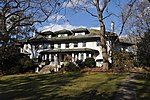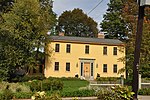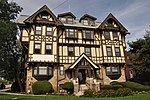Monadnock Road Historic District
Historic districts in Middlesex County, MassachusettsHistoric districts on the National Register of Historic Places in MassachusettsNRHP infobox with nocatNational Register of Historic Places in Newton, MassachusettsNewton, Massachusetts ... and 1 more
Queen Anne architecture in Massachusetts

The Monadnock Road Historic District is a residential historic district encompassing a cohesive subdivision of a former estate in the 1920s in the Chestnut Hill section of Newton, Massachusetts. The development was typical of Newton's explosive residential growth at that time, and includes primarily Tudor Revival houses. The district was listed on the National Register of Historic Places in 1990.
Excerpt from the Wikipedia article Monadnock Road Historic District (License: CC BY-SA 3.0, Authors, Images).Monadnock Road Historic District
Edge Hill Road, Newton Chestnut Hill
Geographical coordinates (GPS) Address Nearby Places Show on map
Geographical coordinates (GPS)
| Latitude | Longitude |
|---|---|
| N 42.334166666667 ° | E -71.179722222222 ° |
Address
Edge Hill Road 17
02159 Newton, Chestnut Hill
Massachusetts, United States
Open on Google Maps









